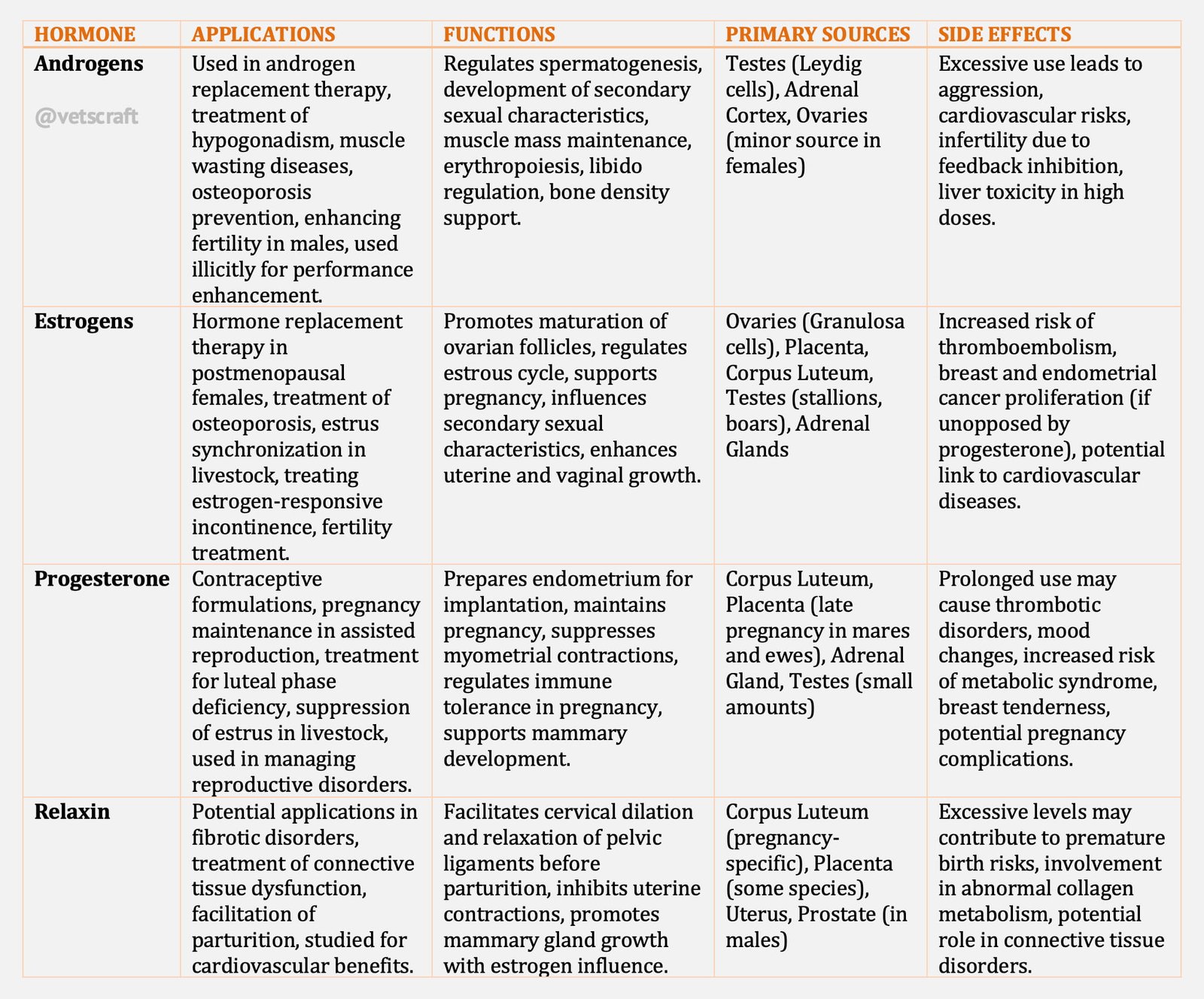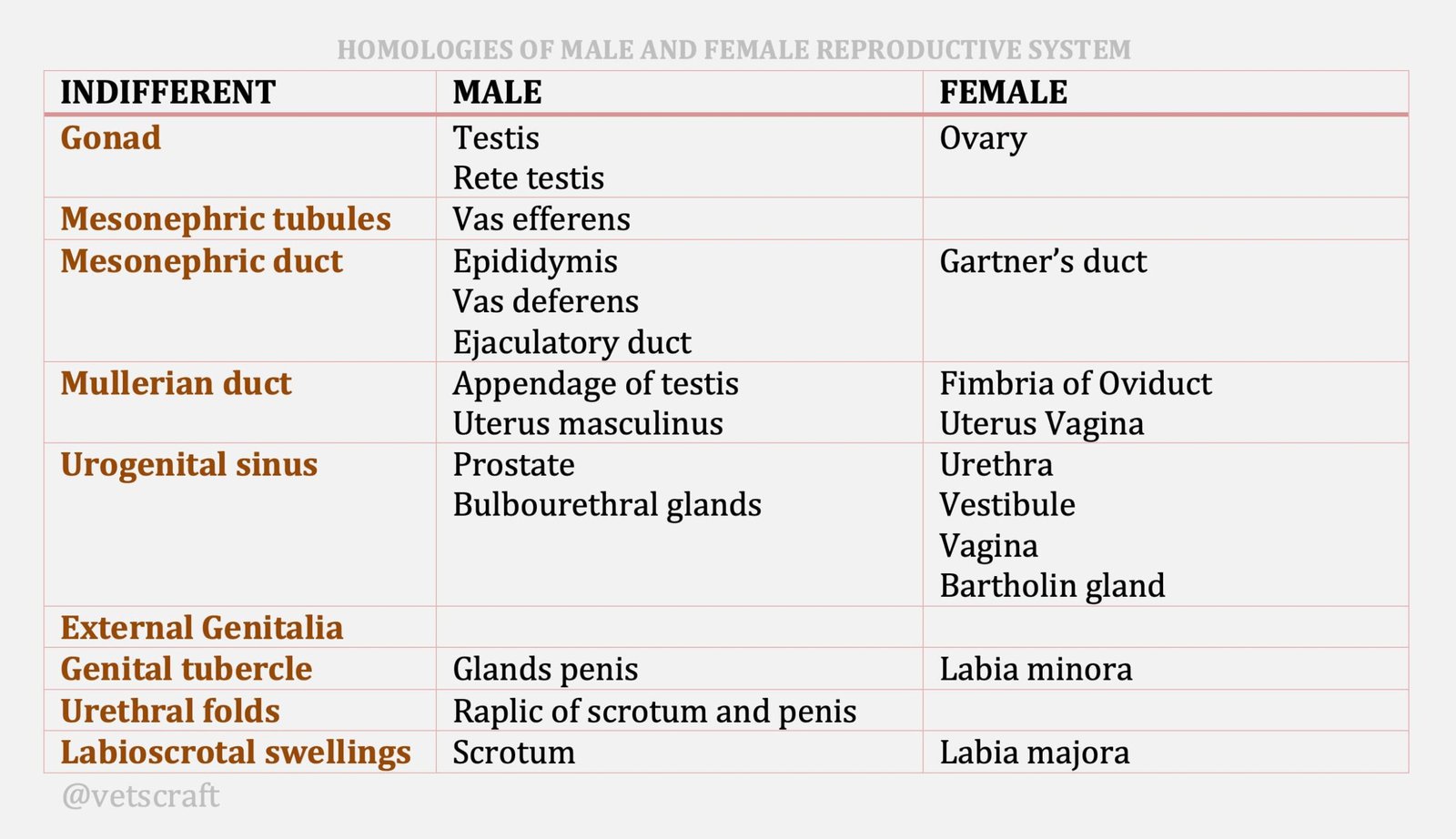TABLE OF CONTENTS
Gonadal Hormones in Animals
Gonadal hormones in animals primarily produced by the testes in males and ovaries in females, play a role in regulating reproductive functions, secondary sexual characteristics, and overall physiological balance.
These hormones include androgens such as testosterone, estrogens like estradiol, and progestogens such as progesterone.
Gonadal hormones in animals primarily secreted by ovary and testes. The adrenals and placenta are other sources as well.
Gonadal hormones in animals are of 4 types:
- Androgens
- Estrogens
- Progesterone
- Relaxin
The first three are steroid hormones while relaxin is a protein.

Steroid hormones have a basic or common nucleus called the cyclopentanoperhydrophenanantherene nucleus. It consists of a three, six member fully hydrogenated phenantherene rings designated as A,B,C and D.
- An 18 carbon steroid has estrogen activity.
- A 19 carbon steroid has androgen activity.
- A 21 carbon steroid has progesterone activity.
The secretory activity of steroid hormones is under endocrine control of anterior pituitary.
Progesterone
Progesterone include the naturally occurring steroid progesterone which is synthesized from cholesterol and produced by the corpus luteum (main source), placenta (especially of the ewe and mare after the first 1/3 and 1/2 of gestation respectively), the adrenal gland and the testes, as well as a number of synthetic progestogens which are much more potent and have a longer half-life than progesterone.
Functions of Progesterone
Progesterone causes growth of the glandular system of the endometrium of the uterus, and the secretions from the endometrial glands (uterine milk) for the nutrition of the ovum and the attachment of the embryo.
- Progesterone plays a role in the maintenance of pregnancy (and pseudopregnancy) by providing a favorable environment for survival of the embryo.
- Progesterone causes growth of the alveolar system of the mammary gland.
- Progesterone inhibits the smooth muscle activity of the uterus-renders it less sensitive to oxytocin.
- Target tissues are relatively insensitive to progesterone unless primed by estrogen-At low levels progesterone acts with estrogen to stimulate ovulation by promoting LH release.
- At high levels progesterone inhibits the secretion of FSH and LH via a negative feedback. However enough FSH is released so that follicles may develop during the luteal phase of the cycle (diestrual ovulation seen in the mare, and also during the gestation period in some species-the mare and to some extent the cow).
- Progesterone increases the efficiency of nutrient utilization.
Applications of Progesterone
- Prevent or control habitual abortion due to an actual or possible progesterone deficiency.
- Estrum deferment or suppression in the ewe, cow, sow, mare and bitch.
- Synchronization of estrus in the mare, ewe, cow and sow.
- In heifers the progestins are used to promote growth – suppresses heat
- To treat post-partum hemorrhage in the bitch.
- In the treatment of cows with cystic ovaries progesterone withdrawal
- In cats progesterone has been used to treat miliary eczema and eosinophilic granulomas.
- Progesterone has a calming as well as androgenic effect and has been used to manage antisocial or aggressive behavior in mares, stallions, dogs and cats.
Problems with Progesterone
If injections are given beyond the recommended length of time, prolongation of the gestation period and fetal death may occur.
Androgens
Androgens are 19-carbon steroids with a hydroxyl or oxygen at positions 3 and 17 and a double bond at position 4.
The androgens are called 17-Ketosteroids when qxygen is found at position 17.
Testosterone is the principal circulating androgen in the male being produced by the interstitial cells of the testis. Other minor sources include the adrenal cortex and ovaries in females.
Functions of Androgens
Testosterone plays roles in:
- Maturation, growth and development of the repro- ductive organs and secondary sex characteristics of the male.
- Erythropoesis
- Protein anabolism
- Maintainance of the secretory responses of the accessory sex organs-provide the fluid component of semen.
- Suppressing the secretion of the pituitary gonado-trophins through negative feedback.
Applications of Androgens
In general, the use of testosterone in large animal is limited to:
- Developing teaser animals
- Induce libido in geldings
In general, there is no fertility condition in the male due to a hormonal cause that uniformly respond to endocrine therapy. The androgens have been used in small animals to manage several problems.
Relaxin
Relaxin is a polypeptide hormone containing alpha and beta subunits that are connected by two disulphide bonds.
It has amolecular weight of 5700 daltons. Inhibin and insulins are structurally similar, but their biological actions are similar.
Relaxin is primarily secreted by the corpus luteum during pregnancy. In some species the placenta also secrete relaxin. In canines, relaxin is a pregnancy specific hormone.
The main biological action of relaxin is:
- Dilatation of cervix and vagina before parturition.
- It also inhibits uterine contractions
- Causes increased growth of the mammary gland if given in conjunction with estradiol.
- In the Guinea pig, relaxin causes seperation of the pubic symphysis bone within 6 hrs after injection. Seperation of pubic symphysis normally occurs during parturition in this species.
Estrogen
The estrogens are steroidal hormones synthesized from cholesterol and produced primarily by the ovaries, placenta and corpus luteum.
A significant source of estrogens is the testes of stallions and boars, while a minor source is the adrenal gland.
The estrogens are metabolized by the liver and excreted in the bile, feces, and the urine (horses and ruminants).
Progesterone decreases the effects of the estrogen and FSH and LH may be involved in estrogen secretion.
Functions of Estrogen
Some important physiological actions of estrogens include:
- Maturation growth and development of the reproductive organs.
- The production of edema in folds of the mucosa at the utero-tubal junction.
- Dilation of the cervix.
- Protein anabolism in ruminants.
- Under the influence of the estrogens the uterus is less susceptible to infection.
- They play a role in the normal health and function of the skin.
- They produce contractions of the uterus.
- They enhance the effects of oxytocin on uterine motility.
- The estrogens inhibit the secretion of FSH and LH via a negative feedback. mechanism
- They are required for the development of the secondary sex characteristics of the female including hair growth, deposition of body fat, mammary gland development, plumage, etc.
- The estrogens are involved in the regression of the corpus luteum.
Stimulation of normal physiological processes of the tubular reproductive tract:
- Growth of the uterine muscle
- Development of the endometrial lining of the uterus
- Increase the vascularity of the uterus
- Induction of behavioral estrus
Applications of Estrogen
- Estrogens are used to evacuate the uterus in cases of fetal mummification, fetal maceration and pyometra.
- They are used to induce abortion in all species.
- They can be used in the treatment of postpartum metritis and retained fetal membranes.
- Used in the management of misalliance in dogs.
- To produce signs of estrus in anestrual animals.
- Treating cases of estrogen responsive urinary incontinence.
- In virgin heifers and dry cows estrogen can be used to stimulate mammary development and lactation.
- Large doses of estrogen after parturition can be used to inhibit lactation and relieve congestion of the mammary glands.
- Used as growth promotants in beef cattle.
- Used in the management of skin condition in spayed bitches.
- In treating male dogs with prostatic hyperplasia.
- Can be used to decrease libido in males.
Side effects of Estrogen
- Prolonged use or large doses can produce cystic ovaries or ovarian atrophy
- Because of its effect on the ligaments, the estrogens predispose to prolapse of the vagina and rectum and dislocations and fractures of the pelvic bones.
- In the dog excessive amounts or prolonged administration of estrogens can produce a fatal anemia-leukopenia and thrombocytopenia.
In some species the estrogens in combination with progesterone may increase the incidence of cystic endometrial hyperplasia-pyometra complex.

